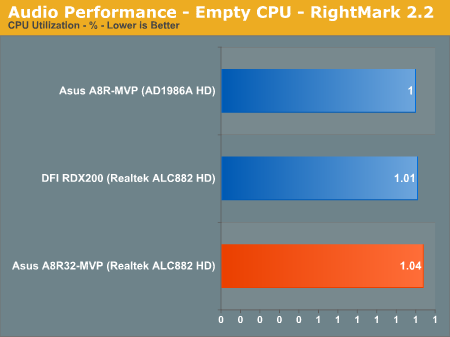Asus A8R32-MVP Deluxe: First ATI RD580
by Wesley Fink on March 1, 2006 9:00 AM EST- Posted in
- Motherboards
Audio Performance
For audio testing, we used the latest version 2.2 of the Rightmark 3D Sound CPU utilization test. This benchmark measures the overhead or CPU utilization required by a codec or hardware audio chip. Versions earlier than 2.2 would not work properly on the RD580 chipset based A8R32-MVP.
Realtek has been very consistent in recent months in releasing regular updates to their HD audio drivers, and we suspect that trend will continue, with ATI and Intel both firmly committed to HD and NVIDIA also introducing hew HD solutions. Each new Realtek update has lowered CPU utilization and we also hope that will continue.
ATI chipset motherboards have the necessary hooks to deliver Azalia High Definition audio. Those who have been complaining about the poor AC’97 audio present on most AMD boards should be very pleased to find Azalia HD on the ATI chipset boards. The nForce4 family does not offer the necessary chipset hooks to support HD Azalia audio on their top Athlon 64 chipsets. However, recent introductions by NVIDIA have included the HD audio option and we expect future NVIDIA chipsets to offer this feature.
For audio testing, we used the latest version 2.2 of the Rightmark 3D Sound CPU utilization test. This benchmark measures the overhead or CPU utilization required by a codec or hardware audio chip. Versions earlier than 2.2 would not work properly on the RD580 chipset based A8R32-MVP.



Realtek has been very consistent in recent months in releasing regular updates to their HD audio drivers, and we suspect that trend will continue, with ATI and Intel both firmly committed to HD and NVIDIA also introducing hew HD solutions. Each new Realtek update has lowered CPU utilization and we also hope that will continue.
ATI chipset motherboards have the necessary hooks to deliver Azalia High Definition audio. Those who have been complaining about the poor AC’97 audio present on most AMD boards should be very pleased to find Azalia HD on the ATI chipset boards. The nForce4 family does not offer the necessary chipset hooks to support HD Azalia audio on their top Athlon 64 chipsets. However, recent introductions by NVIDIA have included the HD audio option and we expect future NVIDIA chipsets to offer this feature.










65 Comments
View All Comments
SuperStrokey - Friday, February 17, 2006 - link
i assume that was not the gtx512 was it? If so wowDeathBooger - Friday, February 17, 2006 - link
http://www.scan.co.uk/Products/ProductInfo.asp?Web...">http://www.scan.co.uk/Products/ProductInfo.asp?Web...If you do a currency conversion it's $217USD. Some lucky guy actually got to buy it before they were supposed to sell it. http://forums.overclockers.co.uk/showthread.php?t=...">http://forums.overclockers.co.uk/showthread.php?t=...
Egglick - Friday, February 17, 2006 - link
Why would you use two different videocards when benchmarking a motherboard?? This really tells us nothing about the motherboards performance in relation to the others, because you have another huge variable.Wesley Fink - Friday, February 17, 2006 - link
As we stated in the test setup we ran BOTH the 7800GTX and the X1900XT video card on the Asus A8R32-MVP. We reported both results so you could compare 7800GTX performance to the previous boards also tested with the 7800GTX. Since the X1900XT is the latest and fastest video card the results were included for Reference only - many would have asked for X199XT results if they were excluded.As someone else pointed out, when testing Dual X16 Video you have to run SLI on nVidia and Crossfire on ATI (or Intel).
andrewln - Friday, February 17, 2006 - link
because you can not run SLI in Crossfire motherboardstuteja1986 - Friday, February 17, 2006 - link
Why didn't Asus include the cool feel as they did with the ASUS A8N 32-SLI. Like the 8-Phase Power and the cool looking Fanless Motherboard cooling system.mino - Friday, February 17, 2006 - link
Just wondering. maybe 8-phase is a waste for ~60 watt Athlon64s. Also why do a fancy(an expensive) "cool looking Fanless Motherboard cooling system" when chipset is cool and doesn not need one at all???I.m glad someone has a sense and doesn't produce third central heater in the system(after CPU & GPU).
Hoping SB600 will be a good one.
Wesley Fink - Friday, February 17, 2006 - link
The RD580 chipset also ran very cool on this board, so there may not be the need for the more exotic passive heatpipe cooling used on the A8N32-SLI.Wesley Fink - Friday, February 17, 2006 - link
The A8R32-MVP was designed to sell for a lower price - probably around $130 to $150, where the A8N32-SLI was designed to sell for $200+. While the A8R32-MVP isn't 8-phase, it actually overclocked ba bit better and gave up nothing to the more expensive and excellent A8N32-SLI in performance. This board can also run dual X1900XT cards in Crossfire mode.tuteja1986 - Friday, February 17, 2006 - link
I wonder how much will it sell for and if it goes arround same price as Asus A8N 32-SLI (220ish). if it cost that much then i will end up buying DFI RD580 motherboard if its got no issue bugs like the 1st rev of DFI RD480 CRossfire.